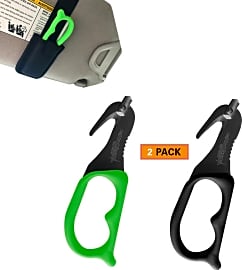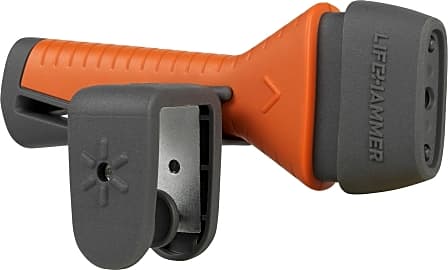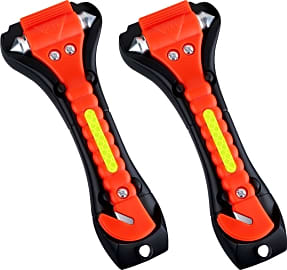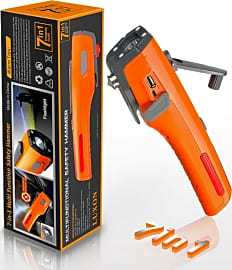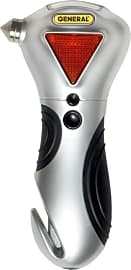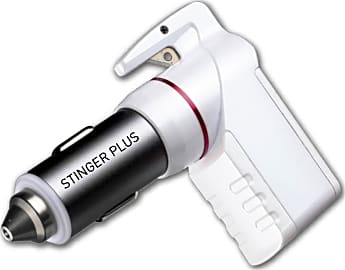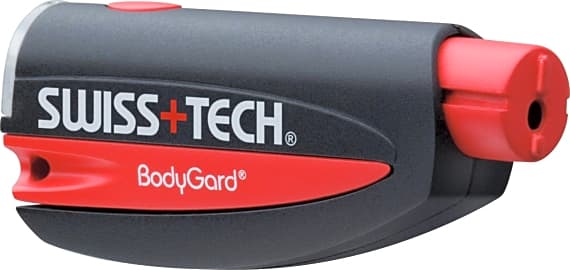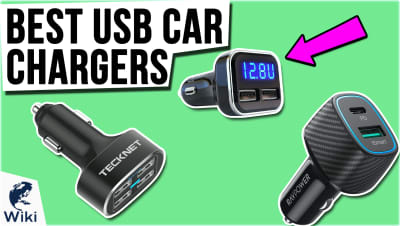The 10 Best Car Escape Tools

This wiki has been updated 37 times since it was first published in October of 2015. In a bad automobile accident, every second counts. Make sure you are fully prepared for an emergency with one of these car escape tools, which include a number of features, including hammers for breaking windows and blades for cutting seat belts. Some also come with flashlights, sirens, and even backup USB power to keep your cell phone working in a pinch. One of these may just save a life one day. When users buy our independently chosen editorial choices, we may earn commissions to help fund the Wiki.
Editor's Notes
June 01, 2019:
A reliable car escape tool should be standard equipment in all vehicles, so we made it a point to include value-priced tools that any car owner should be able to afford. The ResQMe Original and the Vic Tsing Safety Hammer even come in a two-pack so drivers can outfit multiple cars for a the price of a couple lattes. For those who want a more multi-functional tool, the Ingear AutoXscape comes highly recommended because you get a powerful flashlight with the unit, which is always a good idea to have in your car. We thought about removing the Ztylus Stinger Plus because the blade is a little more exposed than on other models, but a small child would still have to work pretty hard and have exceptionally small hands to get in there, plus it's a great choice for people who don't transport small children because when it's plugged into your cigarette charger, you'll always know where it is.
Readiness For Automibile Emergencies
These kits are invaluable in the event of a blown tire, a dead battery, or other issues that render your vehicle inoperable.
According to the United States Department of Transportation's Bureau of Transportation Statistics, Americans spend a lot of time behind the wheel. Here are some facts that might help elucidate that bland claim: Americans take an average of 1.1 billion trips per day, a trip being defined as a point to point journey -- that's four times getting in and out of the car per citizen.
We take an average of 411 billion trips per year. There are well over 200 million personal vehicles ready for private use at any time. On average, an American driver spends just under one hour in the car each day, driving approximately 30 miles in total.
And if you are like the average American driver, you will log around 14,500 miles traveled via car each and every year. For most of us, all the driving comes with little incident. It is still worth remembering the sobering fact that each year, more than 37,000 Americans are killed in car accidents, though, with many more injured, often in life changing ways. If you practice defensive driving, never operate your vehicle under the influence of drugs or alcohol, and always wear a seatbelt and adjust your seat for proper posture and view, then you greatly reduce the likelihood that you will be in an accident. But it's still wise to be prepared for the worst.
Every car should have a roadside emergency kit. These kits are invaluable in the event of a blown tire, a dead battery, or other issues that render your vehicle inoperable. One of the most important aspects of a good roadside emergency kit are those items that help you to be seen from a distance, such as flares and reflectors. Also contained in these kits are ropes suitable for towing, tools such as pliers and screwdrivers, and flashlights.
These kits are important to have on hand for a breakdown or for assistance after a minor accident. In the event of a larger problem, such as a major accident that leaves your car doors jammed and unable to open or your seatbelt twisted too badly to release, you will need a decidedly more aggressive approach to emergency management. A car escape tool does not belong in your emergency road kit, but rather in your glove compartment or center console, if not clipped to the door beside you.
Choosing A Car Escape Tool
Car escape tools are not expensive -- the highest price you could pay for a top of the line model is well under $75. Their low price makes sense given the relative simplicity of these devices. Most car escape tools are designed with only two primary functions: the first is to help you cut through that tough webbing material of your seatbelt; the second is to help you shatter the glass of your car's window.
Any good car escape tool will have an easily accessible razor blade that is safely recessed into its handle and positioned at an angle to easily slice through a seatbelt.
In the normal course of the day, a seatbelt is easily removed by pressing the button beside the buckle to releasing its hold. If the buckle's mechanism has been damaged or destroyed and won't budge, or if you can't reach it based on the car's condition or your position (you may well find yourself hanging upside down after a crash, after all), then that same seatbelt that initially prevented you from being horrifically injured or killed might be an extreme liability if it keeps you stuck in a car at risk of fire, flooding, or being struck by other motor vehicles. Any good car escape tool will have an easily accessible razor blade that is safely recessed into its handle and positioned at an angle to easily slice through a seatbelt.
The second crucial feature of a car escape tool is the glass breaker. These are essentially hammerheads made from steel that come to a point which can concentrate the force of your swing. Used properly, the glass breaker built into your car escape tool will shatter a side window (don't bother trying to use one on the windshield, which is treated specifically to avoid shattering) and allow you to exit the vehicle using the window should the door have been rendered inoperable.
Beyond these two features, you can consider which accessory options you value, such as a built in flashlight or an easy mounting system that keeps your car escape tool in easy reach. In truth, if a car escape tool helps you cut through a compromised seatbelt and break apart a window, it has done its job to the fullest.
What To Do After An Accident
After an auto accident has occurred, time is of the essence. If you are alone, then the process is easier; if you have passengers (or you are a passenger and are not seriously injured) quickly assess their wellbeing and establish whether or not they need assistance.
Pull to the shoulder of the highway or into a lot or onto a side street if you are in an urban or suburban location.
If the accident was minor and your vehicle is operable, you should move it out of the way of the active traffic lanes if possible. Pull to the shoulder of the highway or into a lot or onto a side street if you are in an urban or suburban location. Consider taking several photos of your vehicle and any others involved prior to moving the car, though.
If you have been in a more serious accident and your car cannot be moved, if it is safe to get out of your car without putting yourself on a roadway with moving cars nearby, it is a good idea to exit your vehicle after an accident. Step over a highway's safety wall or get up onto the sidewalk. (Of course you should move farther away if the car is in flames or at risk of being hit by another vehicle.)
Once you are away from the vehicle, contact the authorities at once. Use 9-1-1 if it is an emergency situation with people injured or at risk, and use a non emergency number if the situation is more calm.



